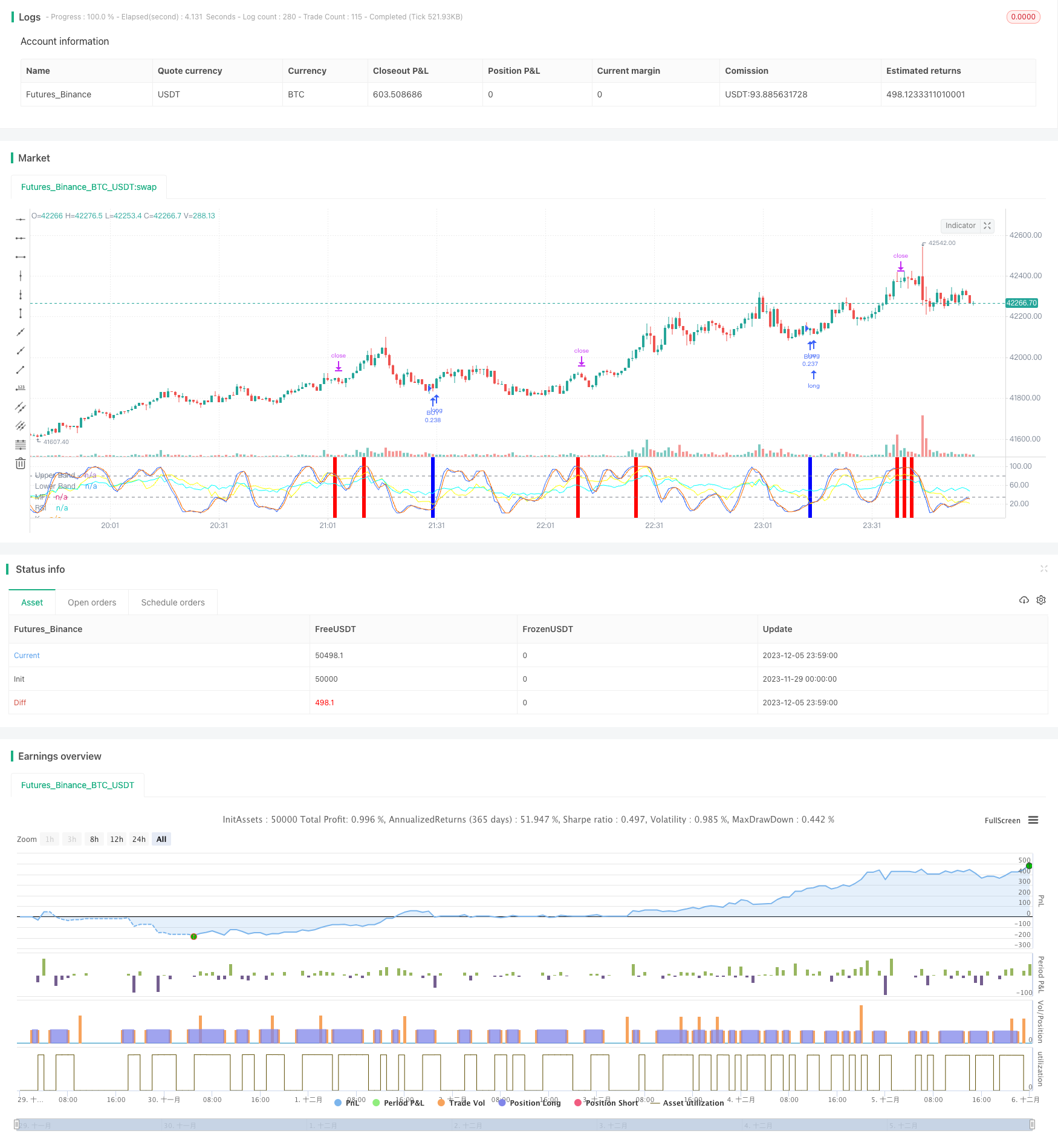
概述
本策略结合RSI、MFI、Stoch RSI和MACD四个指标,实现比特币的日内交易。当多个指标同时发出买入或卖出信号时,策略才会下单,以控制风险。
策略原理
RSI指标用于判断市场是否超买超卖。RSI低于40时产生买入信号,高于70时产生卖出信号。
MFI指标判断市场的资金流动。MFI低于23时产生买入信号,高于80时产生卖出信号。
Stoch RSI指标判断市场是否超买超卖。K线低于34时产生买入信号,高于80时产生卖出信号。
MACD指标判断市场趋势和动量。快线低于慢线且柱子为负时产生买入信号,相反则产生卖出信号。
优势分析
结合四大指标,提高信号准确性,避免因单一指标失效造成损失。
只有当多个指标同时发出信号才会下单,可大幅降低假信号的概率。
采用日内交易策略,避免隔夜风险,降低资金成本。
风险及解决方法
策略交易频率可能较低,存在一定的时间风险。可适当放宽指标参数,增加交易次数。
指标发出错误信号的概率仍然存在。可引入机器学习算法,辅助判断指标信号的可靠性。
存在一定的超买超卖风险。可适当调整指标参数或增加其他指标判断逻辑。
优化方向
增加自适应指标参数功能。根据市场波动度和变化速度实时微调指标参数。
添加止损逻辑。如亏损超过一定比例则止损退出,有效控制单笔损失。
结合情绪指标。增加市场热度、市场恐慌度等多维度判断,提升策略盈利空间。
总结
本策略通过四大指标互相验证的方式发出信号,可有效降低假信号率,是一种相对稳定的高频盈利策略。随着参数和模型的不断优化,策略的胜率和盈利能力还可望进一步提升。
策略源码
/*backtest
start: 2023-11-29 00:00:00
end: 2023-12-06 00:00:00
period: 1m
basePeriod: 1m
exchanges: [{"eid":"Futures_Binance","currency":"BTC_USDT"}]
*/
//@version=5
strategy('John Day Stop Loss', overlay=false, pyramiding=1, default_qty_type=strategy.cash, default_qty_value=10000, initial_capital=10000, currency='USD', precision=2)
strategy.risk.allow_entry_in(strategy.direction.long)
from_day = input.int(defval=1, title='From Day', minval=1)
from_month = input.int(defval=1, title='From Month', minval=1)
from_year = input.int(defval=2021, title='From Year', minval=2020)
to_day = input.int(defval=1, title='To Day', minval=1)
to_month = input.int(defval=1, title='To Month', minval=1)
to_year = input.int(defval=2025, title='To Year', minval=2020)
time_cond = time > timestamp(from_year, from_month, from_day, 00, 00) and time < timestamp(to_year, to_month, to_day, 00, 00)
//time_cond = true
//Stop Loss
longProfitPerc = input.float(title="Stop Loss Profit (%)", defval=2.1) / 100
longExitPrice = strategy.position_avg_price * (1 - longProfitPerc)
//RSI - yellow
up = ta.rma(math.max(ta.change(close), 0), 14)
down = ta.rma(-math.min(ta.change(close), 0), 14)
rsi = down == 0 ? 100 : up == 0 ? 0 : 100 - (100 / (1 + up / down))
plot(rsi, "RSI", color=#00FFFF)
buy_rsi = true // rsi < 40
sell_rsi = true //rsi > 70
//MFI - cyan
mf = ta.mfi(hlc3, 14)
plot(mf, "MF", color=#FFFF00)
buy_mfi = mf < input.int(defval=23, title='Max MF', minval=1)
sell_mfi = mf > input.int(defval=80, title='Min MF', minval=1)
//Stoch RSI
OverBought_StochRSI = input(80)
OverSold_StochRSI = input(34)
smoothK = input.int(3, "K", minval=1)
smoothD = input.int(2, "D", minval=1)
lengthRSI = input.int(14, "RSI Length", minval=1)
lengthStoch = input.int(14, "Stochastic Length", minval=1)
srcRSI = input(close, title="RSI Source")
rsi1 = ta.rsi(srcRSI, lengthRSI)
kStochRSI = ta.sma(ta.stoch(rsi1, rsi1, rsi1, lengthStoch), smoothK)
d = ta.sma(kStochRSI, smoothD)
co = ta.crossover(kStochRSI,d)
cu = ta.crossunder(kStochRSI,d)
buy_stochRSI = co and kStochRSI < OverSold_StochRSI
sell_stochRSI = cu and kStochRSI > OverBought_StochRSI
plot(kStochRSI, "K", color=#2962FF)
plot(d, "D", color=#FF6D00)
h0 = hline(OverBought_StochRSI, "Upper Band", color=#787B86)
h1 = hline(OverSold_StochRSI, "Lower Band", color=#787B86)
fill(h0, h1, color=color.rgb(33, 150, 243, 90), title="Background")
//MACD
// Getting inputs
fast_length = input(title="Fast Length", defval=12)
slow_length = input(title="Slow Length", defval=26)
src = input(title="Source", defval=close)
signal_length = input.int(title="Signal Smoothing", minval = 1, maxval = 50, defval = 9)
sma_source = input.string(title="Oscillator MA Type", defval="EMA", options=["SMA", "EMA"])
sma_signal = input.string(title="Signal Line MA Type", defval="EMA", options=["SMA", "EMA"])
// Plot colors
//col_macd = input(#2962FF, "MACD Line ", group="Color Settings", inline="MACD")
//col_signal = input(#FF6D00, "Signal Line ", group="Color Settings", inline="Signal")
//col_grow_above = input(#26A69A, "Above Grow", group="Histogram", inline="Above")
//col_fall_above = input(#B2DFDB, "Fall", group="Histogram", inline="Above")
//col_grow_below = input(#FFCDD2, "Below Grow", group="Histogram", inline="Below")
//col_fall_below = input(#FF5252, "Fall", group="Histogram", inline="Below")
// Calculating
fast_ma = sma_source == "SMA" ? ta.sma(src, fast_length) : ta.ema(src, fast_length)
slow_ma = sma_source == "SMA" ? ta.sma(src, slow_length) : ta.ema(src, slow_length)
macd = fast_ma - slow_ma
signal = sma_signal == "SMA" ? ta.sma(macd, signal_length) : ta.ema(macd, signal_length)
hist = macd - signal
buy_MACD = macd < signal and hist < 0
sell_MACD = macd > signal and hist > 0
//buy_MACD = true
//sell_MACD = true
//plot(hist, title="Histogram", style=plot.style_columns, color=(hist>=0 ? (hist[1] < hist ? col_grow_above : col_fall_above) : (hist[1] < hist ? col_grow_below : col_fall_below)))
//plot(macd, title="MACD", color=col_macd)
//plot(signal, title="Signal", color=col_signal)
sessionColor = color(na)
if time_cond
if (not na(kStochRSI) and not na(d))
cmt = str.tostring(close)
if (buy_stochRSI and buy_MACD and buy_mfi and buy_rsi)
strategy.entry("BUY", strategy.long, comment='BUY @ ' + cmt)
if longProfitPerc != 0
strategy.exit(id="x", stop=longExitPrice, comment='EXIT @ ' + str.tostring(longExitPrice))
sessionColor := input.color(#0000FF, "buy") //red
if (sell_stochRSI and sell_MACD and sell_mfi and sell_rsi)
strategy.entry("SELL", strategy.short, comment='SELL @ ' + cmt)
sessionColor := input.color(#FF0000, "sell") //green
bgcolor(sessionColor)